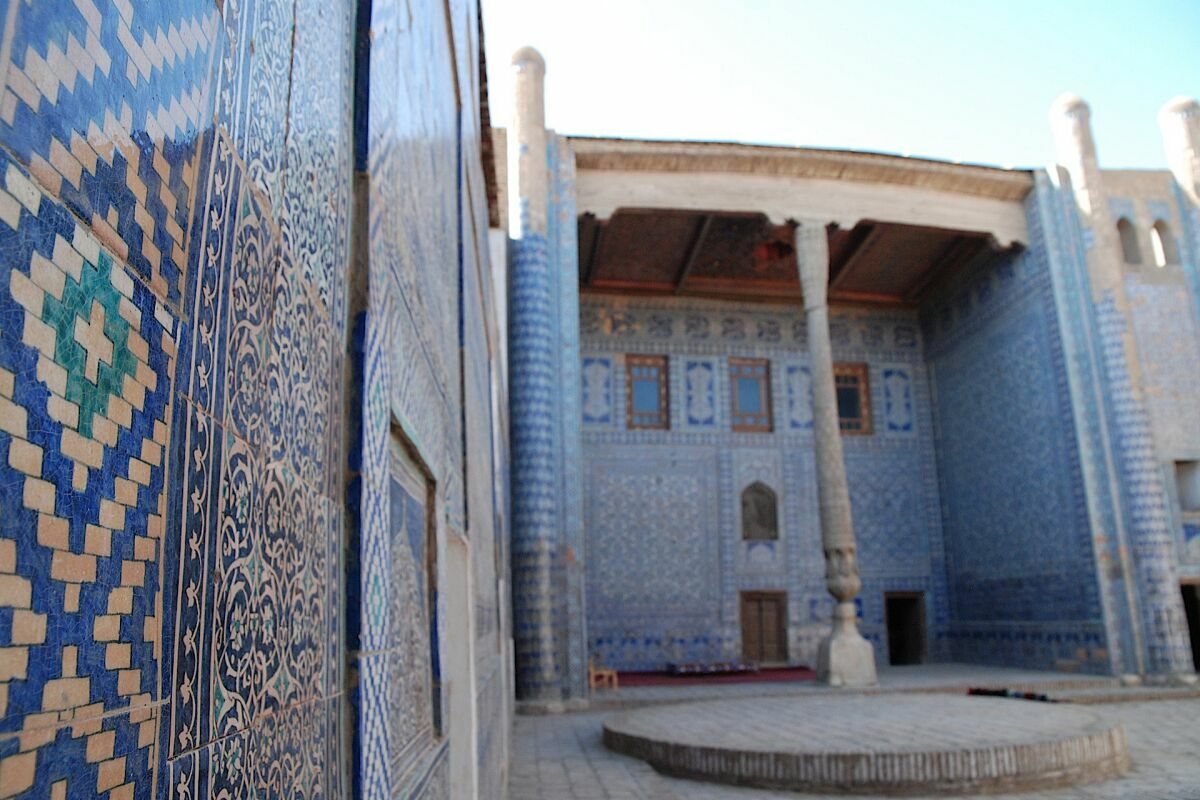Khiva - Harem in Konya Ark

Harem in Konya Ark of Khiva – The citadel of the Khans as a mirror of courtly power and Central Asian architecture
In the centre of the walled old town of Ichan-Qala in Khiva stands a monument that embodies the political, social and cultural history of the former khanate like no other: Konya Ark, the historic citadel and residence of the Khans of Khiva. For centuries, this architectural complex was the administrative, representative and military centre of power – a fortified seat of power where not only court life took place, but also the fate of the khanate was controlled.
The origins of Konya Ark can be traced back to the 17th century, when the khans began to build their own fortified residence within the protective walls of Ichan-Qala. However, the structures visible today date mainly from the 19th century, when under the aegis of Muhammad-Rahimkhan II – one of the last and most important rulers of Khiva – extensive structural extensions and redesigns were carried out. This khan, also known as Muhammad-Rahimkhan the Last, was not only an accomplished statesman, but also a patron of the arts and a poet of distinction.
A complex of courtly complexity: administration, representation, privacy
In many respects, Konya Ark was a microcosm of the khanate: a closed world that united all the elements necessary for the ruler’s governance, representation and private life. The overall complex comprised a large number of functional units, each of which served specific purposes.
The centrepiece was the divan khana – an official audience hall, also known as the salamkhana or arzkhana – where the khan received diplomatic guests, dispensed justice and consulted with dignitaries. This room was an expression of power, legitimacy and order.
In addition, there were economically and administratively important facilities such as a mint, workshops for the manufacture of weapons, grenades and bullets, a large warehouse, a palace kitchen, stables, a covered summer mosque, a winter mosque and a zindan, the state prison.
Konya Ark was given a special touch by the specially constructed ram fighting area, where animal fights were regularly held as part of courtly entertainment. These fights were an expression of both local tradition and the khans’ demonstrative exercise of power over social and cultural life.
The harem: intimacy and social order
The harem – the part of the palace reserved exclusively for the khan’s wives, their children and a limited circle of female servants and attendants – occupied an architecturally and socially prominent position within the complex. The term ‘harem’ is derived from the Arabic ḥarām (‘forbidden’, ‘sacred’) and refers to the spatial and social seclusion of this area, which was separated from the rest of the complex by a high wall and a separate gate – no longer preserved today – in the northern part of Konya Ark.
The harem built by Muhammad-Rahimkhan II is an example of functional clarity and hierarchical order. The architectural organisation was characterised by a linear sequence of residential wings with single-column aiwans in front of them, which provided shade and were grouped around a central courtyard.
Five almost identically designed living quarters, each with its own aiwan, served the khan and his four principal wives. Opposite them were the more modest quarters for the concubines and female servants – a spatial manifestation of the social hierarchy within the harem.
The interior was characterised by simple elegance: walls with gantsch plaster – a traditional, fine plaster – were decorated with elaborately carved stucco reliefs, geometric patterns and tracery niches. These filigree designs reflect the high level of craftsmanship of the Central Asian artisans, whose work did not aim for splendour but for subtle ornamentation.
Muhammad-Rahimkhan II: statecraft and building policy
The completion of Konya Ark under Muhammad-Rahimkhan II marked a high point in the architectural and cultural development of Khiva. The khan, who ruled between 1864 and 1910, was one of the last independent rulers before the complete integration of the khanate into the Russian Empire. His reign was characterised by an awareness of the political threat posed by external powers and a desire to preserve the cultural heritage of his empire.
In this context, Konya Ark was not only restored and extended, but also staged as a symbol of state continuity and cultural sovereignty. The fortress became the representative centre of a political system that was increasingly based on symbolic and historical legitimacy.
Political function and strategic location
Konya Ark was strategically located within Ichan-Qala, the inner city wall of Khiva, which protected the ruler’s seat from external attacks. The elevated position of the fortress allowed a wide view over the surrounding city neighbourhoods – both for control and to symbolically exalt the power of the khan.
The separation from the urban population, but also the proximity to the religious and economic centre of Khiva, underlines the duality of seclusion and accessibility that was characteristic of many Islamic seats of power.
Konya Ark today: preservation and significance
Today, Konya Ark is an integral part of the Ichan-Qala UNESCO World Heritage Site and one of the best-preserved examples of a Central Asian ruler’s palace. The carefully restored structures offer visitors a unique insight into the courtly life of the last khans and the architectural ideals of the 19th century.
The complex is now a museum: Many areas, including the audience hall, the harem and the mosques, are open to the public. Exhibitions document not only the history of the complex, but also everyday life at court, administrative practices, the work of Muhammad-Rahimkhan II and the art and architecture of the era.
Konya Ark thus not only embodies the historical power of Khiva, but also serves as a living testimony to the political, social and cultural organisation of one of the last independent Central Asian khanates. In its clarity, functionality and craftsmanship, it is a masterpiece of Central Asian architecture – and a key to understanding the history of this region.
